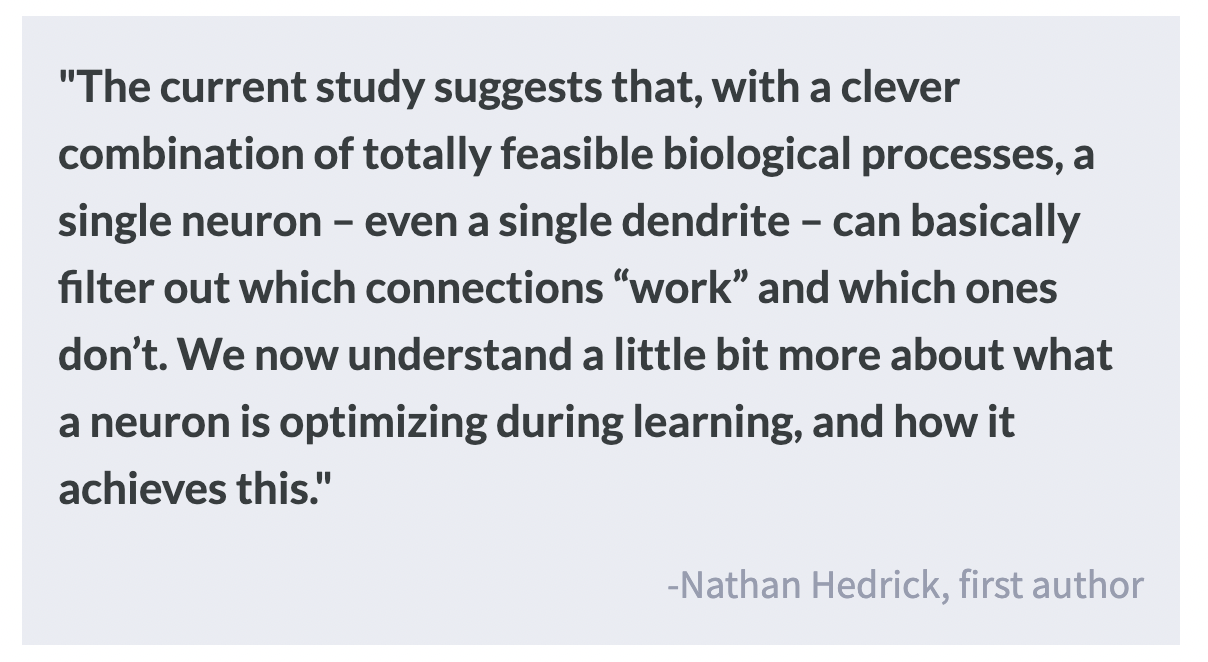How New Neural Connections are Formed During Learning
Post by Shannon Kelly
The takeaway
New neural connections formed during learning tend to be active at the same time as other neural connections being used during learning and form in close proximity to them.
What's the science?
Previous research has shown that learning involves physical changes in connections between brain cells. These changes include the growth of new structures called “spines”, on neuronal dendrites which correspond to new connections with other neurons. However, the process by which learning causes the formation of these new spines is not yet well understood. This week in Nature Neuroscience, Hedrick and colleagues used microscopic brain imaging techniques to show how the activity of nearby connections affects the formation of new neural connections in the brains of mice while learning a new behavior.
How did they do it?
The authors measured the activity of existing dendritic spines and the growth of new spines on neurons in the primary motor cortex in adult mice over two weeks. During these two weeks, mice in the learning condition completed daily training in which they were given a reward for pressing a lever in response to hearing a specific noise. A control group of mice was rewarded regardless of whether they pressed the lever. Spine activity and growth were measured during training sessions using in vivo two-photon imaging, which uses fluorescent markers to provide high-resolution imaging of brain activity and structure at the level of individual brain cells, and even individual spines (~100 times smaller than cells). They examined the degree to which activity, location, and potentiation (the increase in strength of a neural connection with increased use) of existing spines affected the growth and maintenance of new spines. For a subset of the mice, they also used electron microscopy to examine mice brains after the final training session to study the structure of new connections developed during learning.
What did they find?
For mice in the learning condition, new spines formed more often near clusters of existing spines that were active during lever presses (movement-related spines) as well as near spines with high potentiation. These findings suggest that the location of new spine formation on the dendrite is guided by the activity and potentiation of pre-existing spines during performance of the behavior that is being learned. These new spines tended to be active at the same time as existing movement-related spines, and their combined activity was more prominent when mice showed the learned behavior pattern, suggesting that new spine development supports the performance of the learned behavior. Electron microscopy showed that filopodia (precursors of new spines) are more frequently located near fully developed new spines, suggesting that multiple new filopodia are produced physically close to each other in “hot spots”, and those that successfully connect to other neurons become new spines. Finally, new spines that tended to be active at the same time as nearby movement-related spines were more likely to remain throughout the study, while those whose activity was not related to that of movement-related spines disappeared by the final training sessions, indicating that new spines whose connections support learning are selectively maintained, likely by their synchronized activity with nearby movement-related spines.
What's the impact?
These results provide a model that describes how dendritic spines are developed and maintained during learning. This model fills a gap in what was previously known about the biology of learning by explaining the process by which the growth of new spines occurs and how it supports the learning of new behavior. Future research can build on these findings to describe the broader network that is developed through new spine growth to improve our understanding of how the aggregation of information from other brain regions supports learning.


